Blog
September 22nd, 2011
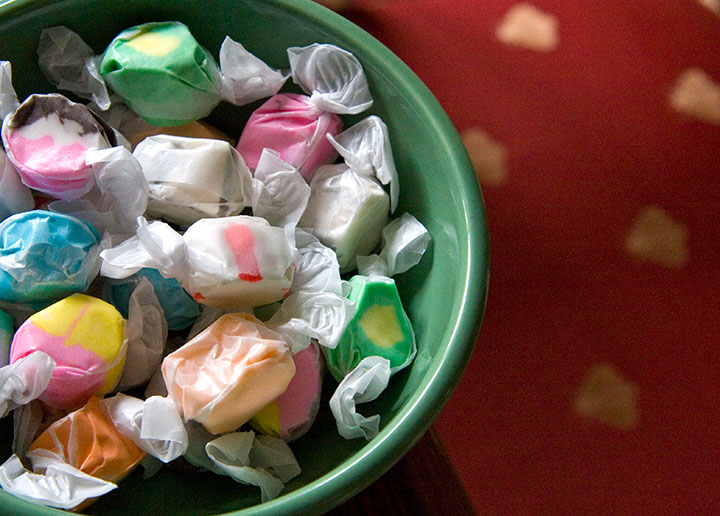
Splurging on a giant bag of salt water taffy is probably a weird way to research a new project, but I swear it’s relevant.
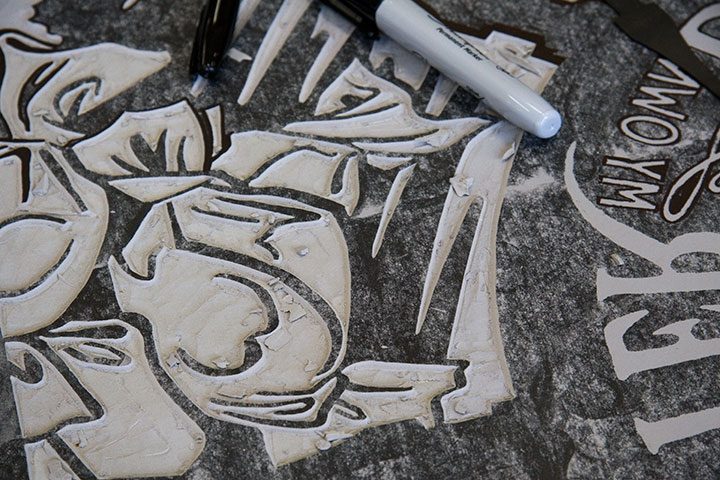
That’s right—Jessica and I are carving again. We’ve been invited by the good folks at the San Francisco Center for the Book (big shout-out to the amazing Rocket!) to be among the featured artist at their eighth-annual Roadworks festival this weekend! Needless to say, we’re super excited.
So if you’re in the Bay Area, swing on by the Potrero and check it out—it promises to be a real hootenanny. The party will be taking up a whole block, chock full of artist vendors, food carts, letterpress demos, and, of course, steamroller printing! And since these guys are rumored to be the original, no-kidding inventors of steamroller printing, they’ll show you how it’s done, for real. Here’s the scoop:
Roadworks 2011
Saturday, September 24
12 to 5 pm, Free!
Hosted by the San Francisco Center for the Book
Rhode Island Street, between 16th and 17th Streets
San Francisco, CA
As a bonus, stick around afterward for a gallery reception for the steamroller prints at 6 pm. There’ll be drinks, music, and a whole lot of loopy artists covered in ink.
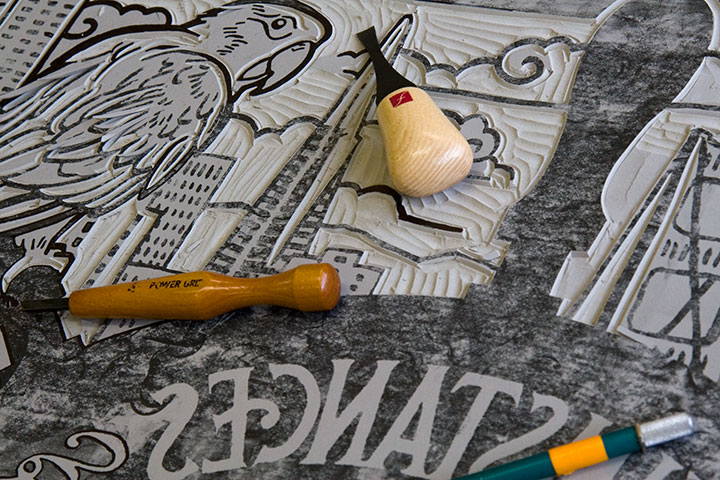
We’ve designed a brand-new, San Francisco-themed, honorary Dead Feminist for the occasion. I won’t reveal who she is until we get back, but here’s a hint: she knew her way around a fo’c’sle and a taffy pull equally well.
And of course, in honor of our muse, we’ll be sharing that salt water taffy at our table. It’s the good stuff, we promise. (Well, we had to sample it, didn’t we?)
See you in San Francisco!
August 3rd, 2011
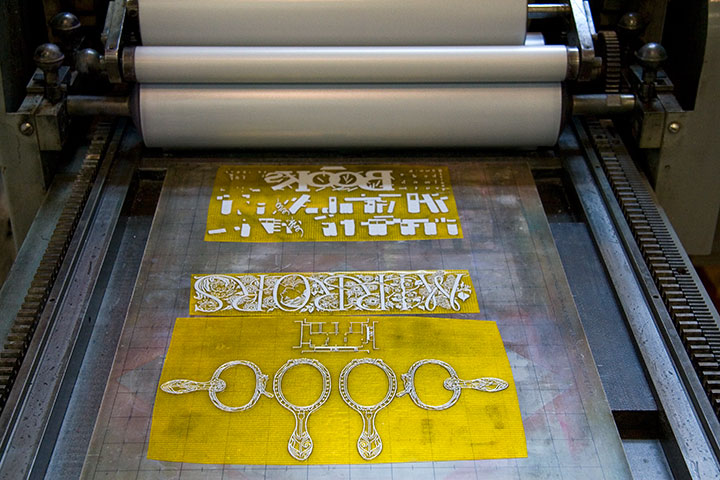
Whew. I’m home from one adventure, but I’m about to turn right around and go off on another. There was just enough time between trips to do a little scribbling, a little scrambling—and maybe a wee bit of nervous screaming as the seconds counted down.
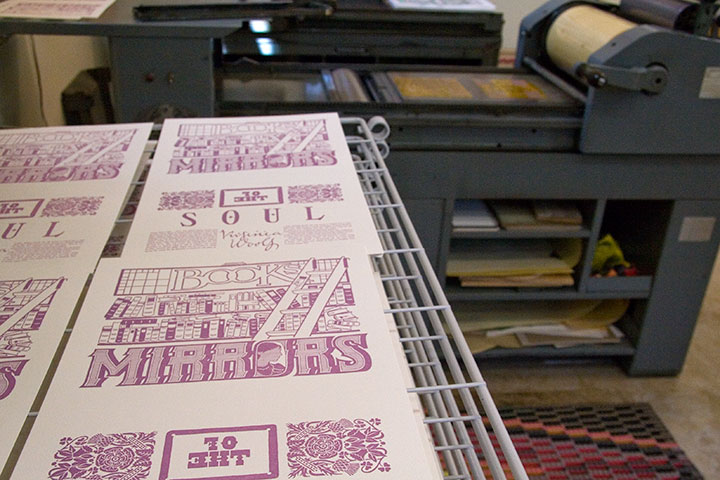
We made it, though—and now, on this summer that’s had me scattered to the four winds, there’s just one compass point left to explore. So Jessica and I are off to Asheville, NC for the first-ever Ladies of Letterpress Conference, finished goodies in hand. When we come back next week, we’ll have a new broadside for you and a whole lot of tales to tell.
Happy trails!
May 30th, 2011
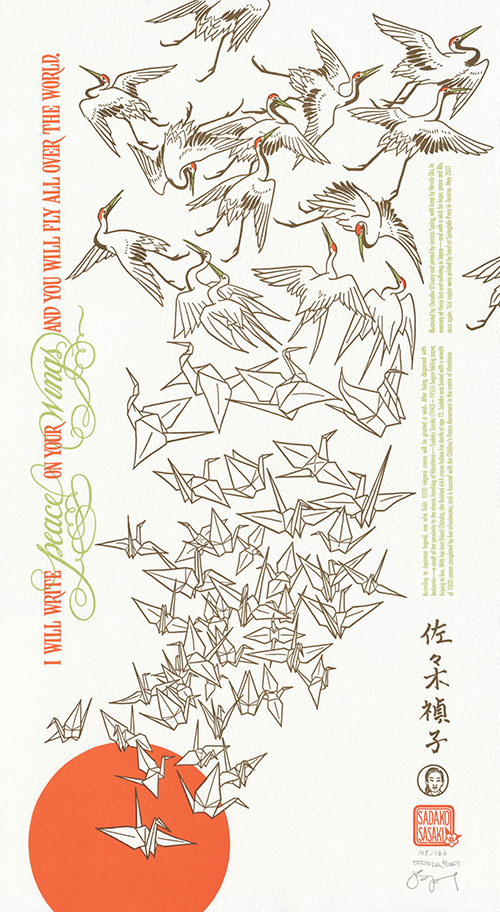
Today is Memorial Day in the United States, a holiday designated for the remembrance of those lost in time of war. But on this day, Jessica and I can’t help but extend our thoughts to others as well, in the spirit of peace. Today our eyes and hearts are trained on the far shores of the Pacific, where the people of Japan are still reeling from the March 11 earthquake, tsunami and nuclear disaster. So for our twelfth Dead Feminist broadside, we remember them by giving wings to the words of our youngest-ever feminist:
I will write peace on your wings and you will fly all over the world. — Sadako Sasaki
As you can probably tell, this piece is a bit of a departure from our usual way of doing things. This time it just didn’t feel right to let the typography run amok, or to fill every inch of real estate with illustrated goodies. So instead, we simply opened the door and let our imaginations take flight. The quote stands quietly apart, running parallel to a flock of origami cranes rising upward from a persimmon sun. As they follow Sadako’s words and wishes, they transform into red-crowned tancho cranes, disappearing off the page.
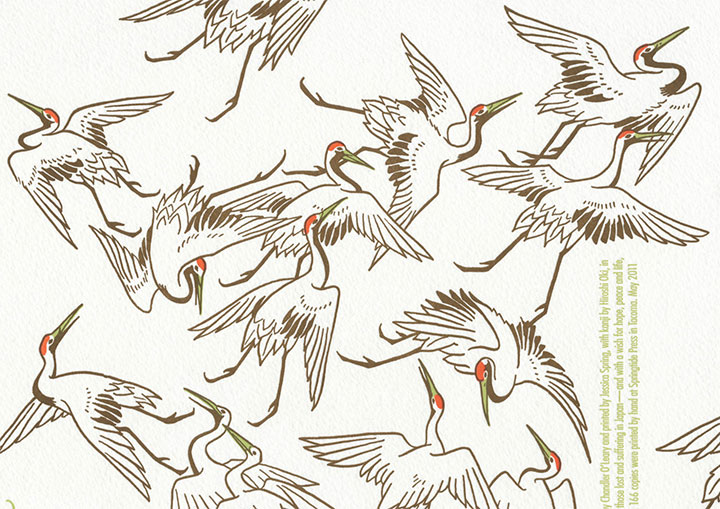
Since the traditions and history of Japanese printmaking are a veritable goldmine, the sky was literally the limit when it came to inspiration. But I had something particular in mind:

On the left is is Cranes and New Year Sun by Utagawa Hiroshige; on the right is Katsushika Hokusai’s famous Great Wave Off Kanagawa. You can see a reference to Great Wave at the bottom of Cranes—making references to both other artists and one’s own older work is a common convention in Japanese art.
I had the good fortune of seeing Cranes and New Year Sun in person earlier this year at the Tacoma Art Museum. Not only is it a beautiful image, it has an interesting quirk that sort of stuck in my craw. See that line running halfway through the composition on the left? The piece is made up of two sheets of paper; it was originally designed to function as the front and rear endsheets of a book. As far as I know, the original viewer never would have seen the image as a whole—and maybe never would have given it a second thought. But together, the two halves of the image form a stunning vertical composition that I wanted to reference for our piece.
There’s also a bit of a practical homage for us here: just as Hiroshige’s illustration is made up of two parts, each one of our Dead Feminist broadsides is also comprised of two halves. For us it’s purely a technical limitation—Jessica’s platemaker can only make plates that are about 8 x 10 inches in size. So since each of our prints is 10 x 18 inches, we have to break the illustration up and print it in two sections: one set of plates for the top, and another for the bottom. So that means that somewhere in every one of our broadsides, there’s a little break running horizontally through the composition. We usually try to hide it as cleverly as possible, or at least blend it in with the overall design, but it’s always there. Take a look at some of our previous prints and see if you can find it. (Mind the gap!)
Anyway, Hiroshige is not the only person we have to thank for all of this. I’d also like to send out a special, winged bit of gratitude to Hiroshi Oki for providing us with his exquisite kanji (Japanese calligraphy) rendition of Sadako’s name—and to his daughter Shiori for introducing us.
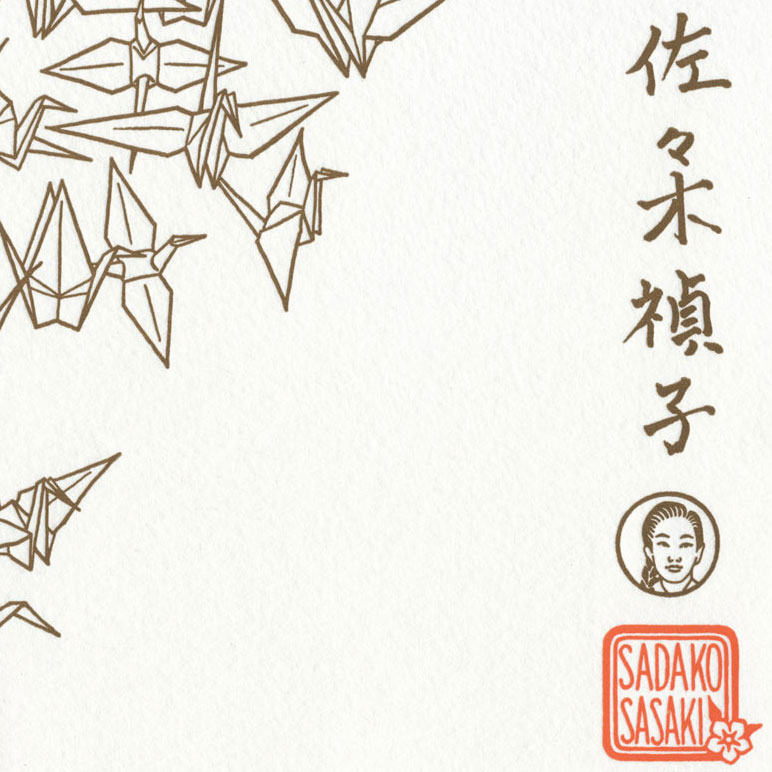
The thing that has just enchanted us both about this project is the very idea of imbuing paper with a wish—of creating something so labor-intensive and time consuming, and then sending it out into the world for a greater purpose. Sadako wasn’t the only person to fold cranes for a wish, but she might be the most well-known. Every year, on the anniversary of the atomic bombing, Sadako’s monument in Hiroshima is festooned with thousands upon thousands of cranes—so many that permanent shelters have been erected there to house and protect them. And even in Western countries, it’s become somewhat of a tradition to give senbazuru (a set of 1000 paper cranes) as a gift to cancer patients. Talk about a ripple becoming a tidal wave.
In that spirit, we’ll be donating a portion of our proceeds to Peace Winds America, a non-profit organization based in Seattle and dedicated to disaster response worldwide. The donation will be directed to the Japan Relief & Recovery Fund, used to rebuild local infrastructure and restore the livelihoods and communities of those affected by the earthquake and tsunami. We’d like to think of this as a little senbazuru of our own.
• • • • • • • • • • • • • • • • • • • • • • • • • • • • • • • • • • • • • • • • • • • • • • • • • • • • • • • • • • • •
Peace Unfolds: No. 12 in the Dead Feminists series
Edition size: 166
Poster size: 10 x 18 inches
Printed on an antique Vandercook Universal One press, on archival, 100% rag paper. Each piece is numbered and signed by both artists.
Colophon reads:
According to Japanese legend, one who folds 1000 origami cranes will be granted a wish. After being diagnosed with leukemia—a result of her proximity to the atomic bombing of Hiroshima—Sadako Sasaki (1943 – 1955) began folding paper, hoping to live. With her best friend Chizuko, she finished 644 cranes before her death at age 12. Sadako was buried with a wreath of 1000 cranes completed by her schoolmates, and is honored with the Children’s Peace Monument in the center of Hiroshima.
Illustrated by Chandler O’Leary and printed by Jessica Spring, with kanji by Hiroshi Oki, in memory of those lost and suffering in Japan—and with a wish for hope, peace and life, once again.
UPDATE: poster is sold out. Reproduction postcards available in the Dead Feminists shop!
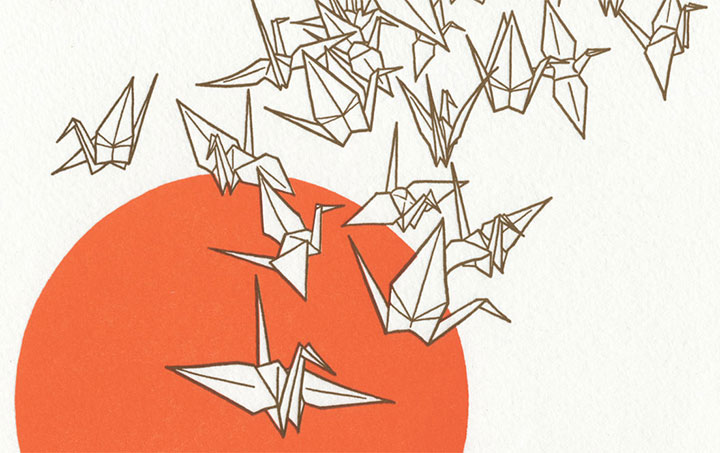
May 28th, 2011
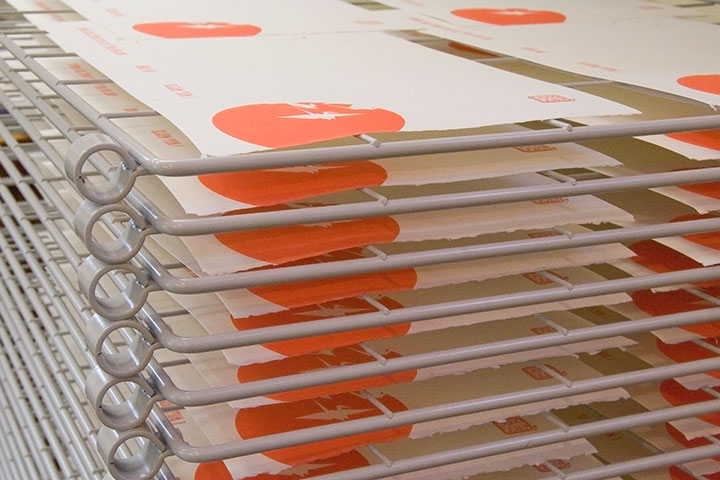
I’m still not sure how it happened, but it’s May already—and that means Jessica and I are due for another broadside. This weekend, while everyone else is grilling hot dogs, we’re cooking up something entirely different. Now, if only print racks left behind those tasty-looking grill marks…
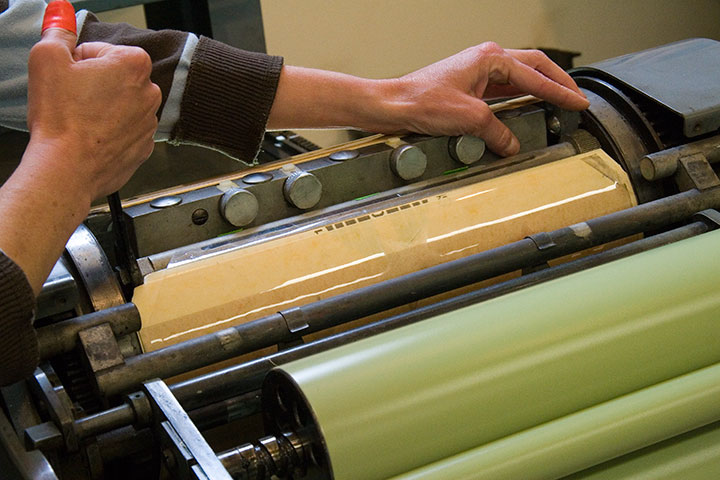
Memorial Day has a little bit of a part to play in the new piece, so we’ll be unveiling it here on Monday.
In the meantime, have a safe and happy holiday weekend (and to all our friends outside the U.S., a safe and happy regular weekend!). See you soon.

April 12th, 2011

Jessica and I have locked ourselves in her studio with an armful of Talking Heads records (go, portable turntable!) and some very sharp knives. Don’t worry about us, though—it’s just an annual tradition here in T-town.
That’s because this Sunday is the seventh annual Wayzgoose, that crazy letterpress block party that draws hordes, flocks, gaggles of people to King’s Books for some seriously huge fun. And we’ll be polishing up our street cred with the main event—steamroller printing. We’ll be pounding that pavement come rain or shine (please, pray for shine), so stop by and check it out!
7th Annual Wayzgoose
Sunday, April 17, 2011
11 am to 4 pm, Free!
King’s Books
218 St. Helens Ave., Tacoma, WA
Near the top of a very long list of things I love about Tacoma is the sheer number of people here who know what the heck a Wayzgoose is. If you haven’t experienced ours yet for yourself, you’re in for a treat. Meet a whole host of local and regional artists; shop a huge array of letterpress art and gifts; make your own books and posters; and don’t forget to bring a t-shirt! The D.I.Y. screen printing booth will back by popular demand, and this year, some of the street-printing artists (including yours truly) are going to have bite-sized versions of their steamroller designs ready to be made into t-shirts. I know what I’ll be wearing this weekend.
Speaking of which … Jessica and I don’t want to ruin the surprise, so we’re keeping our design under wraps for now. But let’s just say that this year we’ll be getting our feathers ruffled—
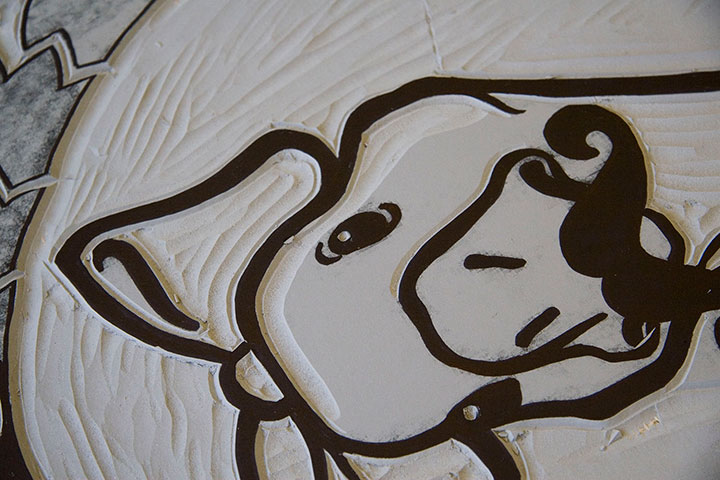
—and breaking out the ‘stache wax.
See you Sunday!
January 20th, 2011
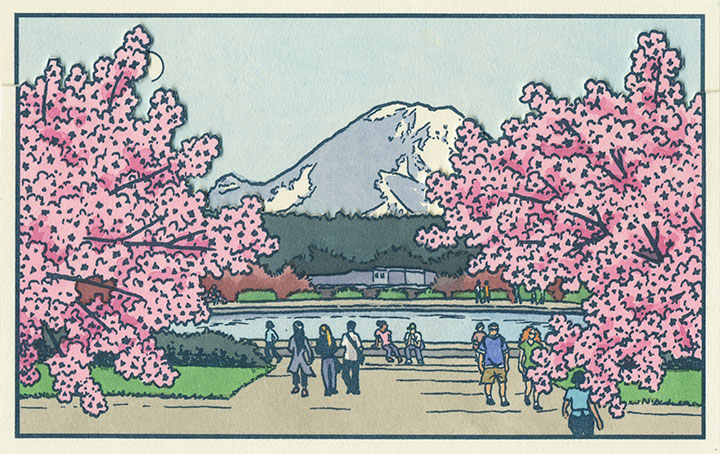
A composite of two image flats from the book.
Anyway, after a good, long run, my Local Conditions exhibit is closing tomorrow afternoon, and this week I’ve been revisiting some of my favorite images from the book. This one always gets me thinking about how much a city can change over the course of a century, and how for a newcomer like me, that change isn’t always apparent. There aren’t always little plaques or signposts to tell you what used to exist where you’re standing now—or even any evidence at all of how things used to be.
This scene depicts the Drumheller Fountain (also known as Frosh Pond), located on the University of Washington campus in Seattle. Incidentally, on my first trip to the Northwest almost exactly four years ago, I was standing on this very spot when I saw Mt. Rainier for the first time. This is where the idea for the book first struck me—although at the time it was a very different, and much simpler concept. And at that moment, I had no idea that the view itself had a history all its own.
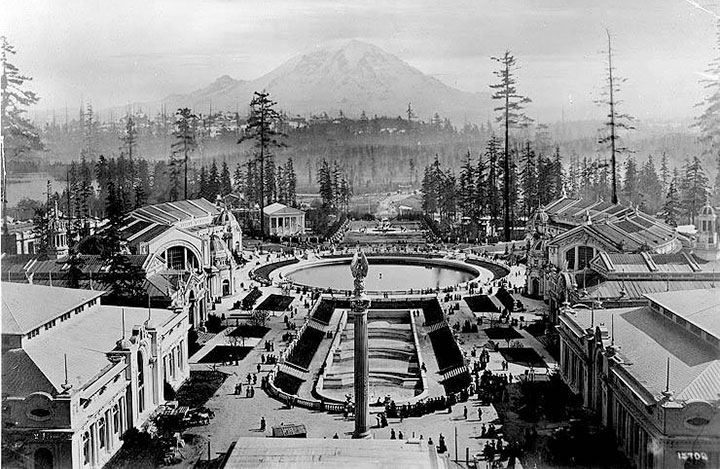
AYP and Camp Harmony images courtesy of the University of Washington Library
This is Frosh Pond in 1909, when it was called Geyser Basin (part of the so-called “Arctic Circle”), and when it was not a part of campus, but the centerpiece of the University’s predecessor, the Alaska-Yukon-Pacific Exposition.
An event similar to a World’s Fair, the A-Y-P showcased the natural and economic resources of the Pacific Northwest with pomp and splendor. To mirror the purpose of the exposition, the fairgrounds (designed by the famous Olmsted Brothers) brought the region’s greatest symbol into stunning focus. This so-called “Rainier Vista,” culminating in the Arctic Circle, helped draw in 3.7 million visitors over the fair’s four-month duration.
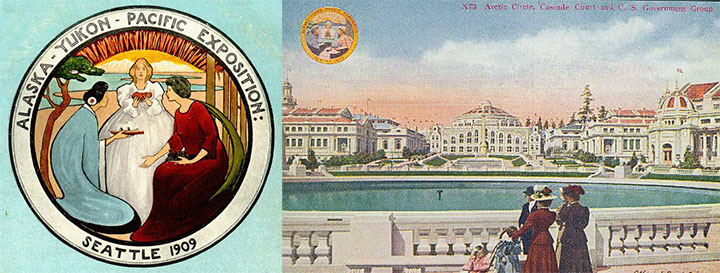
Very little evidence remains of the A-Y-P fairgrounds today (much to my chagrin); the vast majority of the fair’s buildings were temporary, and even the landscape design of the modern University has all but obscured the original layout of the A-Y-P grounds. But the Arctic Circle is still there, and when you step out from behind a row of blooming cherry trees in the spring, the Rainier Vista still hits you with full force.
Speaking of fairgrounds, closer to T-Town is another historical remnant—this time, however, instead of a long-past event with only a marker left behind to hint at what was, these fairgrounds still hold to their original purpose today.
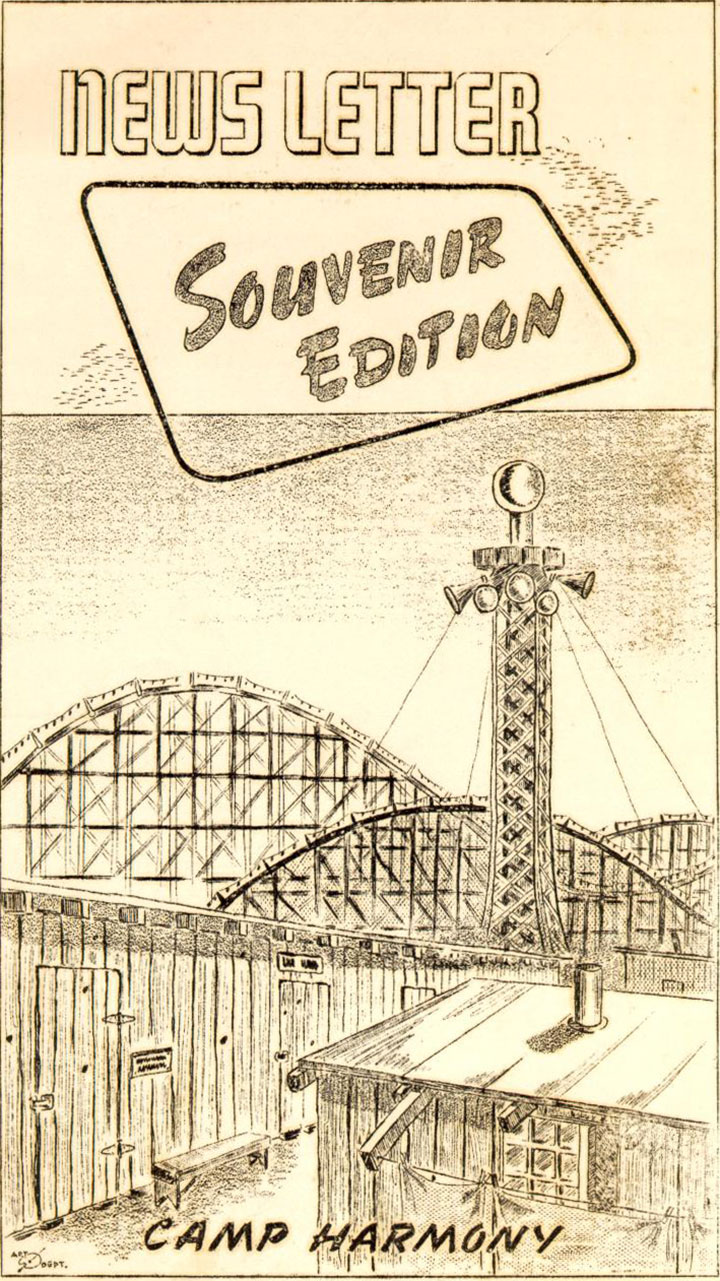
Illustration by Eddie Sato, Camp Harmony inmate and “staff” artist.
I’m talking about the Western Washington Fairgrounds in Puyallup, which are still in operation (though the event is now called the Puyallup Fair—that’s pronounced “Pew-AL-up”). In 1942, the U.S. government evicted, rounded up and imprisoned over 100,000 Japanese Americans living on the West Coast; the internment began with the forced migration of families living on Bainbridge Island, across the Sound from Seattle.
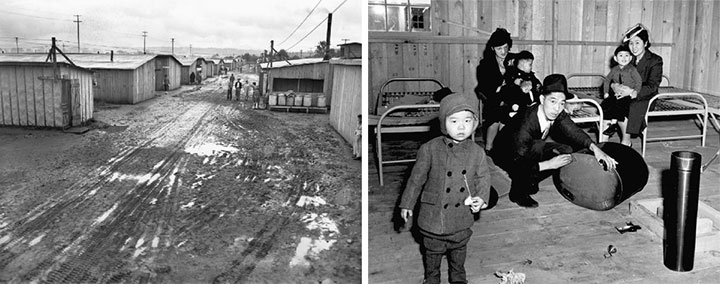
While they awaited the construction of permanent internment camps further inland, many Japanese Americans were sent to temporary “assembly centers” to coexist in cramped barracks with other families, often in substandard living conditions. Thousands of Washington’s interred residents were sent to the assembly center nicknamed “Camp Harmony,” hastily constructed on the fairgrounds in Puyallup, right alongside the fair’s permanent buildings and rides.
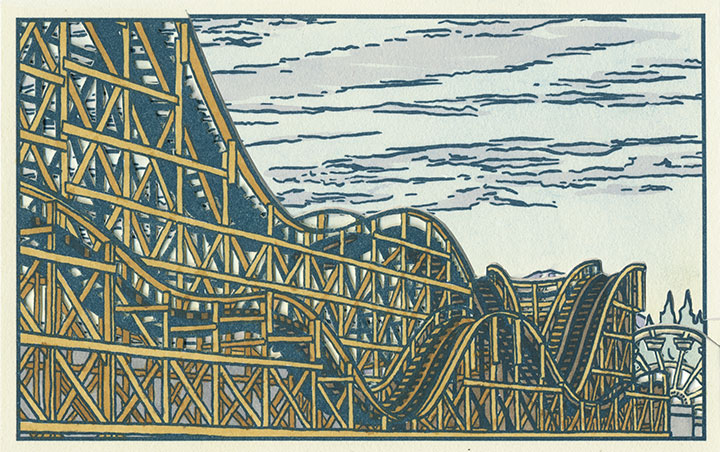
Three image flats; the mountain is almost completely hidden here.
Camp Harmony was torn down after just seven months, but the Fair continues to this day. (To my everlasting horror, the Fair’s website mentions Camp Harmony only obliquely on its “History” page—it states only that “the fairgrounds were used as a temporary shelter“—emphasis mine—during World War II. Right. A shelter where the “refugees” were imprisoned under armed guard.) And the wooden roller coaster that overshadowed Eddie Sato’s scene of the camp still stands. Now that I’ve learned the history of the place, I’ve lost my appetite for rollercoasters, funnel cakes and blue-ribbon vegetables. But the fairgrounds made for an image that dovetails eerily well with the homage to Japanese art upon which Local Conditions is founded.

Photo courtesy of Jessica Spring
And then there’s the kind of history that unfolds right before your very eyes. Remember the Luzon building?
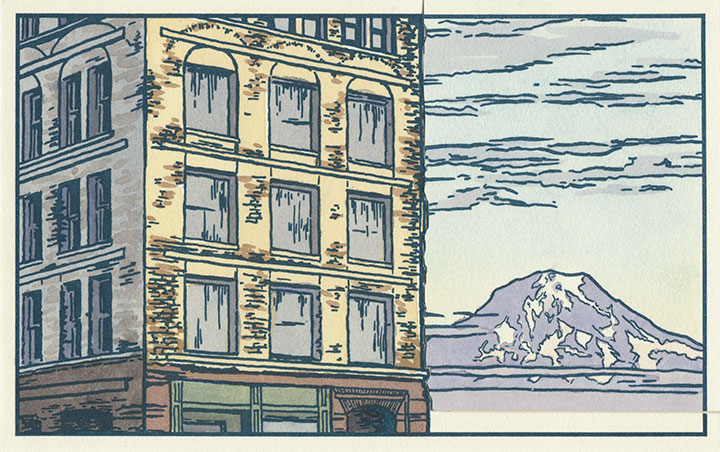
Two image flats; recognize the sky in the background?
Well, it was slated to be a part of the book from the very beginning—just by virtue of being a structure that caught my eye and that came with a good view of the mountain.
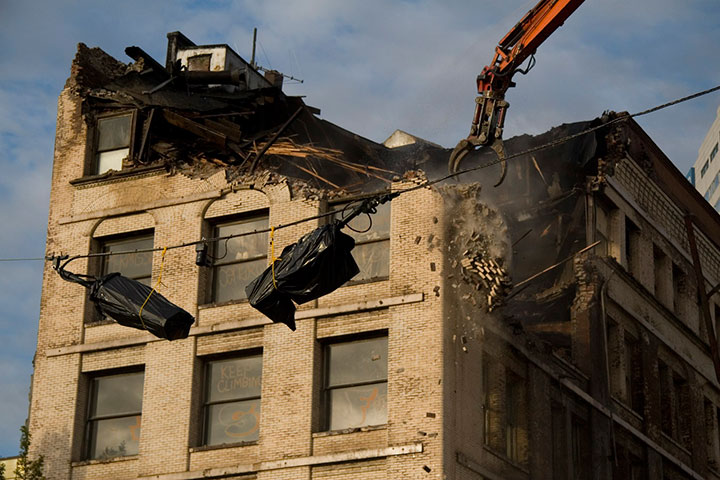
But then they knocked it down in September 2009, and suddenly I became an eye-witness, with an opportunity to document history as it happened.
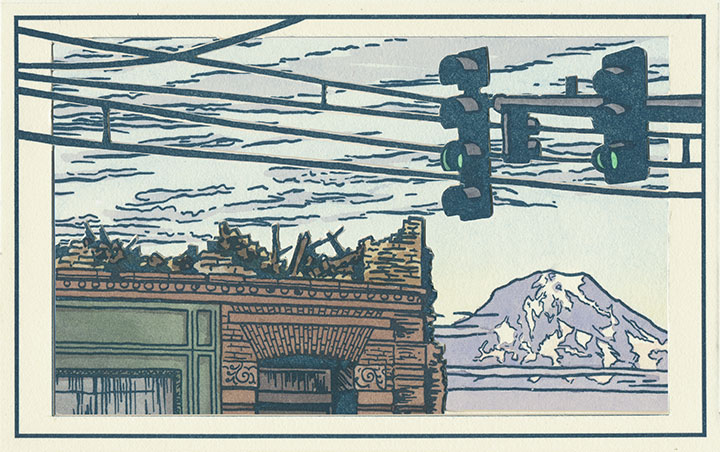
Three image flats; same mountain, drastically different view.
I wish this were an imaginary scene, but it’s moments like this that the book is all about. Now you see it, now you don’t.

Postcards circa 1910. Courtesy of the Tacoma Public Library
And to top it all off, it’s looking like Tacoma’s history is in danger of repeating itself. This is a postcard dated 1905, depicting what was an iconic view even then—the “Gateway to the City of Destiny.” The building on the left is the former Northern Pacific Railroad Office; on the right is Old City Hall.
Tacoma built a new city hall a few blocks away in the 1930s, but both the Northern Pacific building and Old City Hall still stand—the addition of a freeway the only major change to the site pictured. But on November 24, 2010, after an unusual cold snap, a pipe burst in Old City Hall—soaking the walls, ceilings and floors with 30,000 gallons of water. With extensive flood damage and the building owner entering foreclosure, the building faces an uncertain future. I only hope it doesn’t go the way of the Luzon.
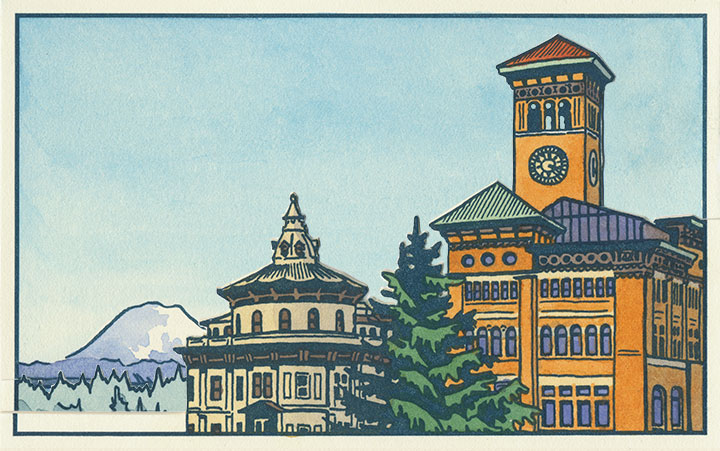
Three image flats; there’s an individual print version in the shop.
When I started this project, I had no idea of what I was getting into. I knew that I would stumble upon some pretty fascinating history, but I never would have guessed that a fountain, some fairgrounds and a pile of bricks would draw me in so completely. But now I’m hooked—and the best part is that after all this work, I no longer feel like an outsider looking in.
This is my history now, too. For better or worse, I want to see how it all plays out.
December 25th, 2010
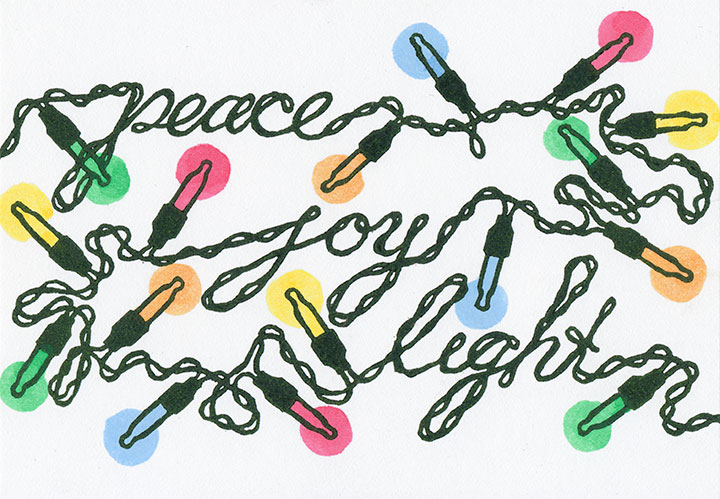
I was afraid I wasn’t going to have any holiday photos to show you—when I was in Portland the other week, my camera took a nosedive after being bumped off my shoulder in a crowded room.
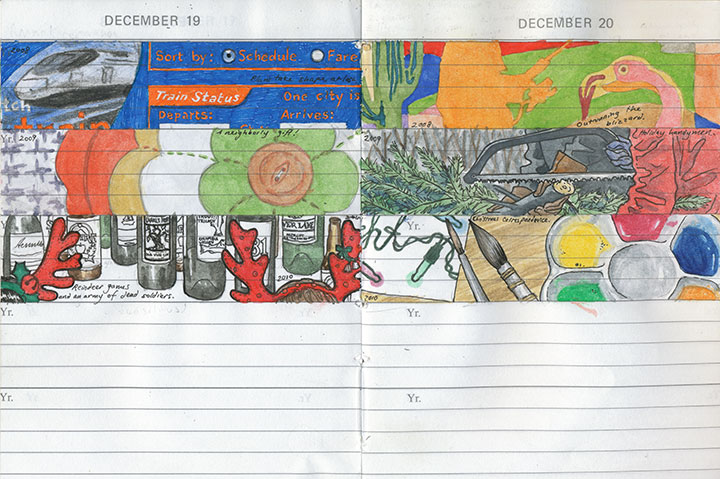
Snippets from my daily journal
So I shipped the lens off to the good folks at Canon for repair, and switched to paper for awhile.

One of Maurice Sendak’s eye-candy stage sets for the Pacific NW Ballet’s Nutcracker
My favorite thing about sketchbooks is that I can take them anywhere—including places where cameras, functioning or not, are strictly verboten.
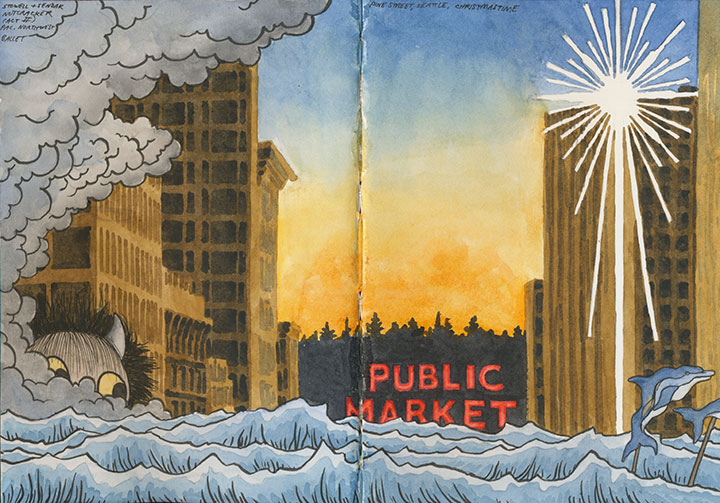
More Nutcracker scenery, plus Christmas on Pine Street in Seattle
The downside, though, is that it takes me a lot longer to draw a picture than to shoot one—so my output is always smaller than I’d like.
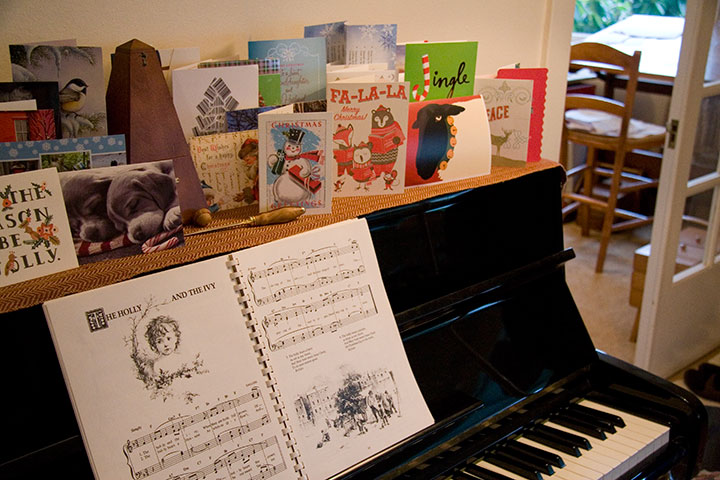
But then the Fedex guy showed up with my lens, good as new and just in time for Christmas.

I managed to refrain from hugging him, and then hopped around the house in manic glee, documenting the holiday the Tailor and I have spent all week creating.
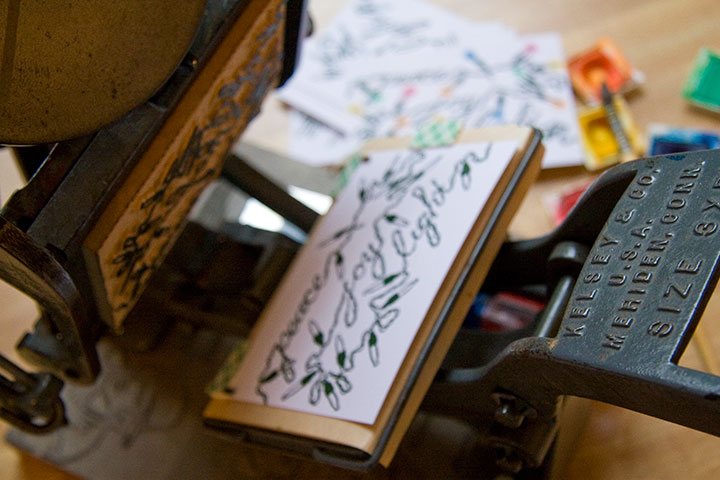
(We finally broke down and bought twinkle lights for the tree; which provided the perfect inspiration for this year’s card!)
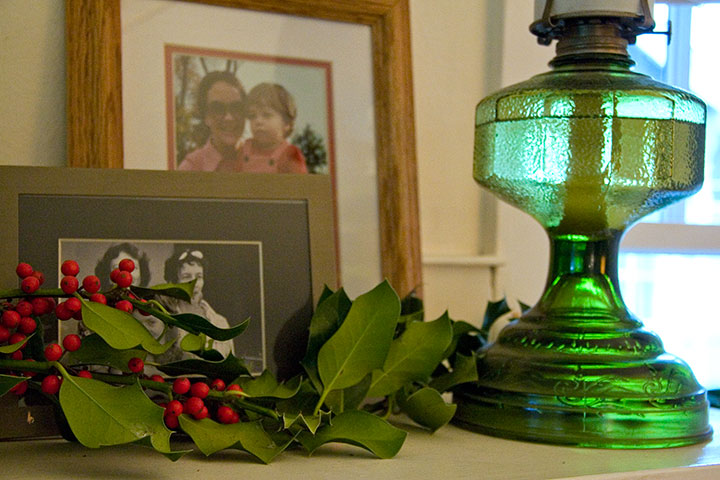
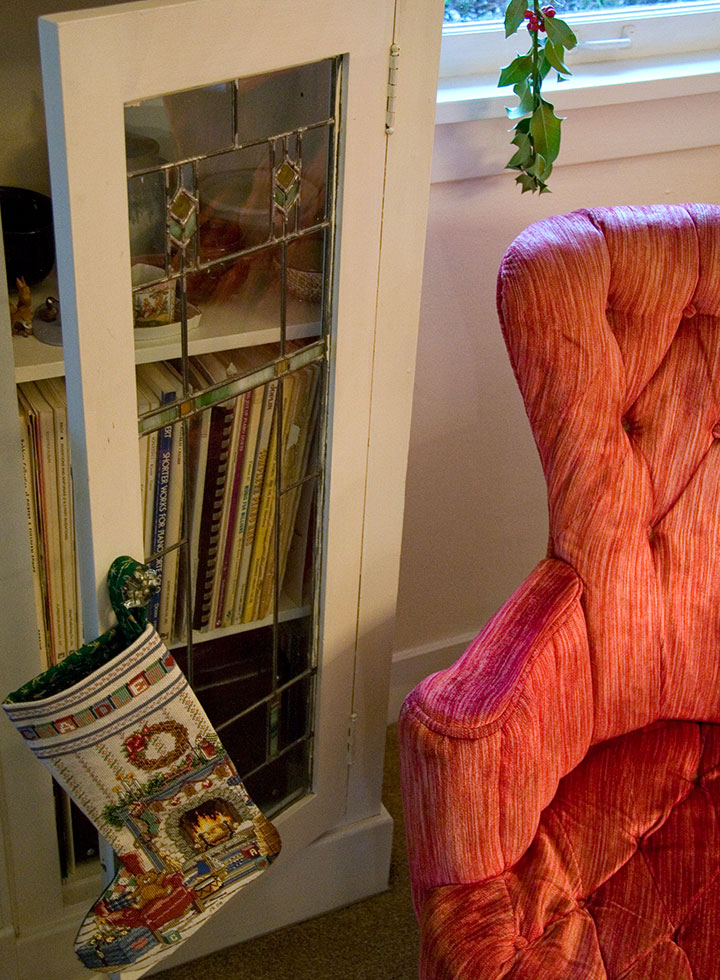
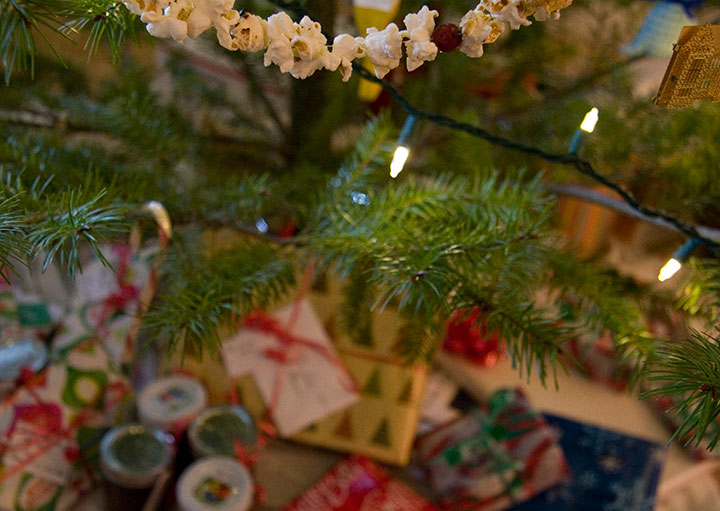
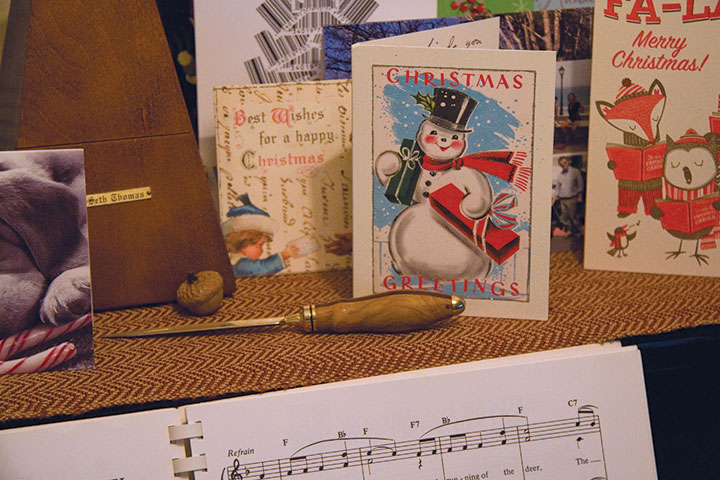
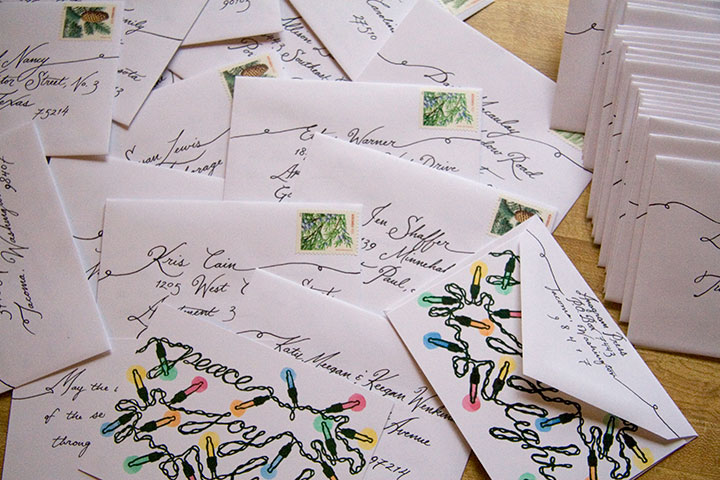
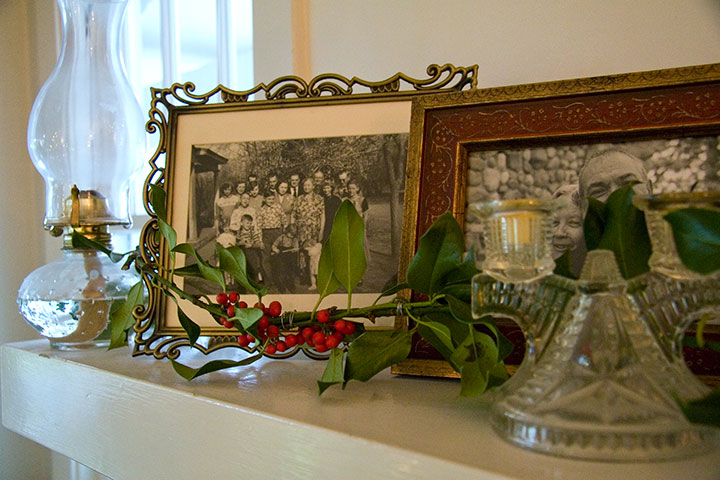
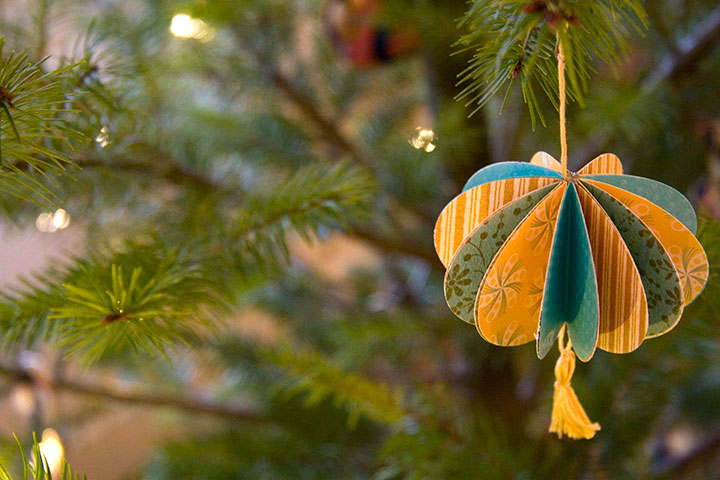
Wherever today finds you, have a warm, cozy, abundant, and very merry Christmas.
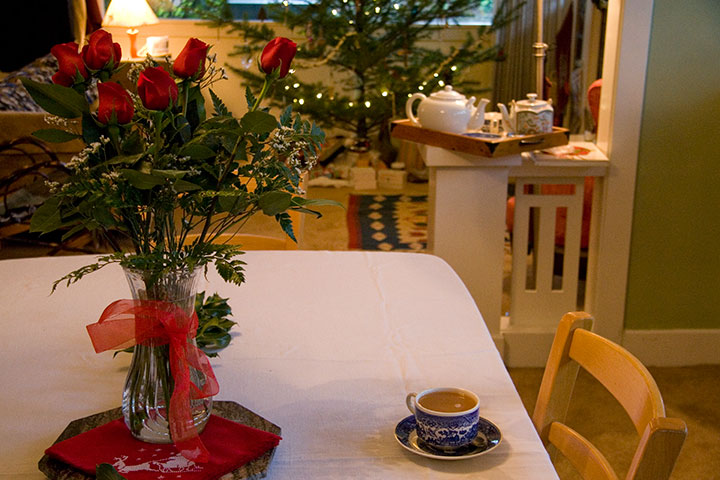
December 1st, 2010
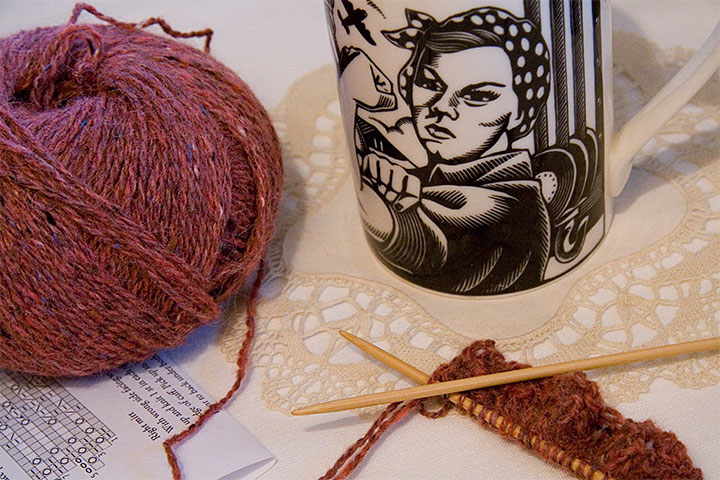
You know what? It’s pretty dark here in the winter.
No, I mean really dark. Not just a sunrise-at-eight-pitch-black-by-five dark, but a kind of silver pall that sets up a permanent residence, even at midday, and makes you forget about the sun. It’s absolutely beautiful when you’re taking a walk in the fog, or curling up with your trusty Rosie mug and a hank of yarn. Not so great when you really need a lot of natural light, though—like, say, for shooting photographs…
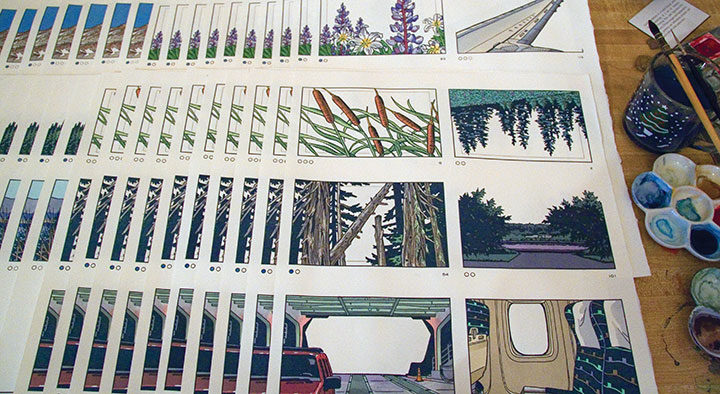
…or mixing paint to fill in a huge stack of glorified coloring book pages.
So between the short daylight hours and a desperate need to reserve a little personal time, work on the book has slowed from a breakneck pace to a stately, clip-clopping trot. I still have so much to show you—so much to explain—but my head needs to catch up with my hands first (or is it the other way around?). I’m going, then, to break it up into a series of posts, and take a little extra time to gather my thoughts before I start. I don’t mean to string you along; because the process required working with a kind of tunnel vision for so long, I’m only just now seeing the “finished” product myself. So thanks for your patience—and for being interested enough to stick with me.
Thank you also for the huge outpouring of support you’ve shown since I posted this thing a couple of weeks ago. The comments, links, blog features, Tweets, emails, and amazing reviews are just overwhelming. I simply can’t find the words, except—thank you.
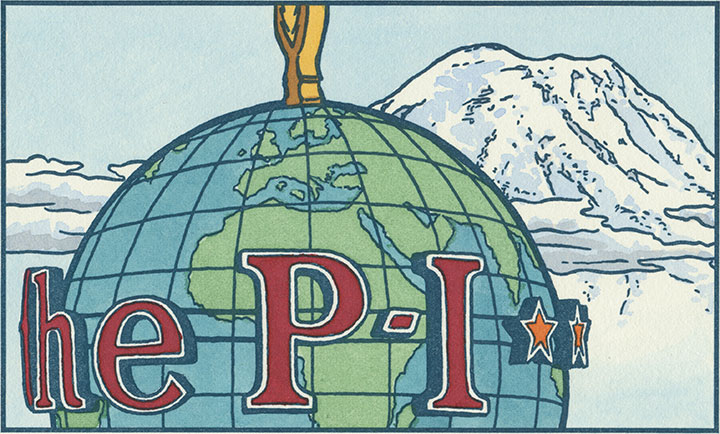
Part of what’s taking me so long is that at the same time, I’m working on a small series (like a baker’s dozen or so) of individual prints of images from the book (exhibit A above). There’s not a whole heap of rhyme or reason as to which illustrations I’ve chosen, except that these are some of my favorites. I’ll be posting them in the shop (believe me, they’ll be a lot more affordable than the book) as I finish them.
In the meantime, it’s time to light a few more lights, and keep the dark at bay so I can see what I’m doing.

Which reminds me—Happy Hanukkah!
November 17th, 2010
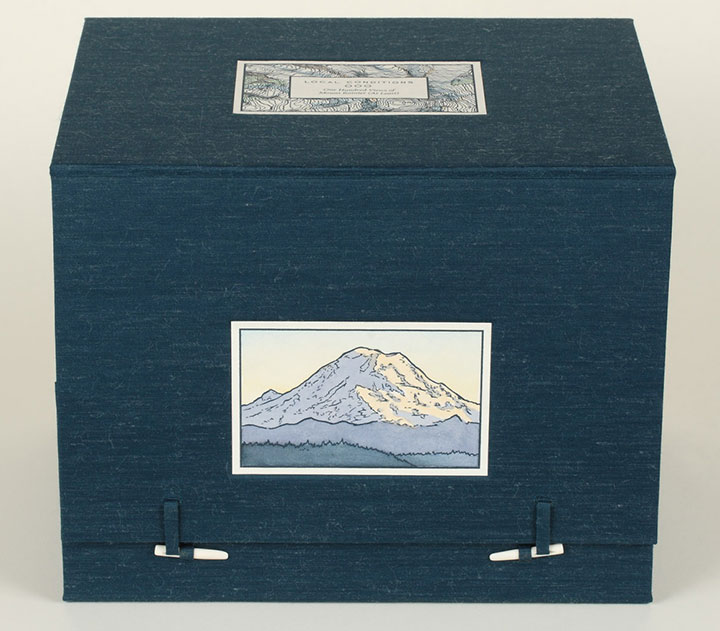
I’ve been hemming and hawing about how best to share this thing with you. Even with Sarah’s excellent photography, it’s just a lot more difficult to explain how it works when I can’t hold the book out into space and demonstrate in real time. It’s a problem with every artist book out there—an interactive sculpture, complete with moving parts, that also happens to tell a story is just dern hard to document.
So for now, I’m going to go through the mechanics of the thing, step by step, and go into the whys and wherefores in other posts. And for those of you who might not be familiar with the term artist book, you’re going to find out really quickly that this isn’t your basic hardcover book. The definition of “artist book” is way too broad to go into within this post (click the above link to go to what I wrote on my F.A.Q. about it), but I’m hoping that by the time you get to the bottom of this post, you’ll have an idea of just how broad the term can be—and what crazy things can happily fall into the category.
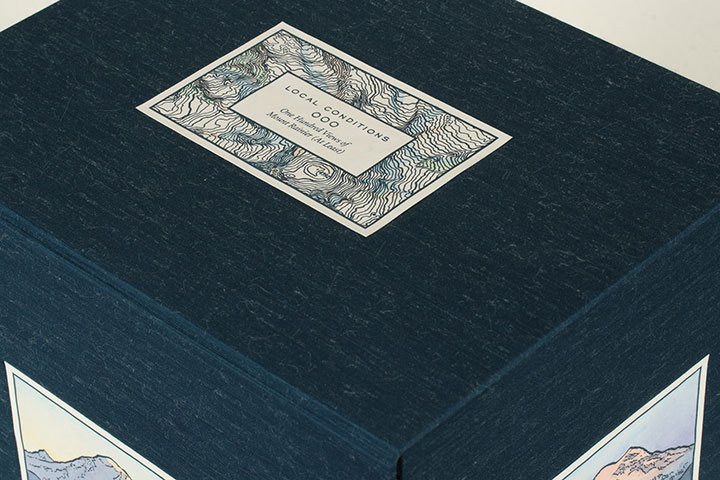
Okay, let’s start with the box. When it’s all closed up, Local Conditions is almost a cube (a 10-inch cube that’s heavy enough to be hiding a sack or two of flour inside). On the topmost face of the box is the frontispiece, containing the title and a topographic map illustration of the summit of Mt. Rainier.
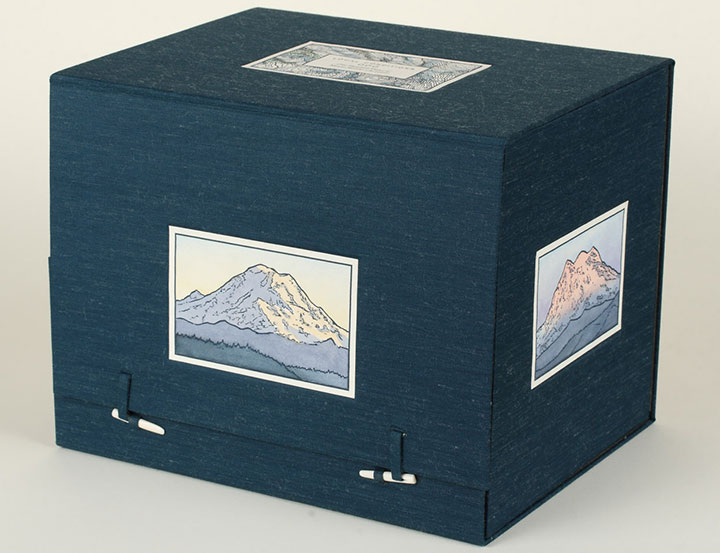
The north, south, east and west sides of the box are faced with illustrations of the corresponding faces of Rainier, each depicting the mountain at sunset.
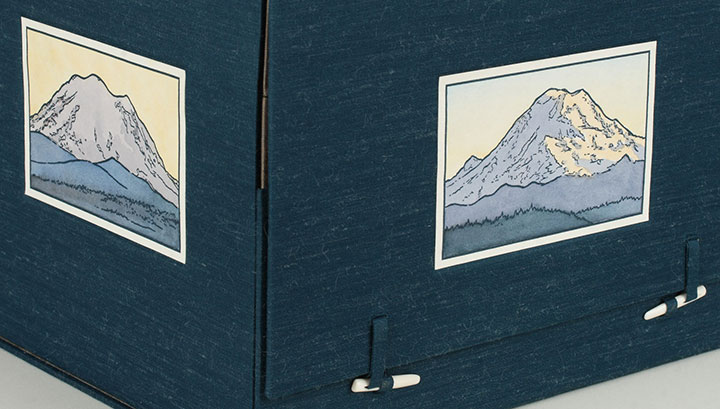
(That’s the eastern face on the left, and the north face beside it.)
Now, those two little bone clasps hold the thing together, and when you flick them out of their loops,
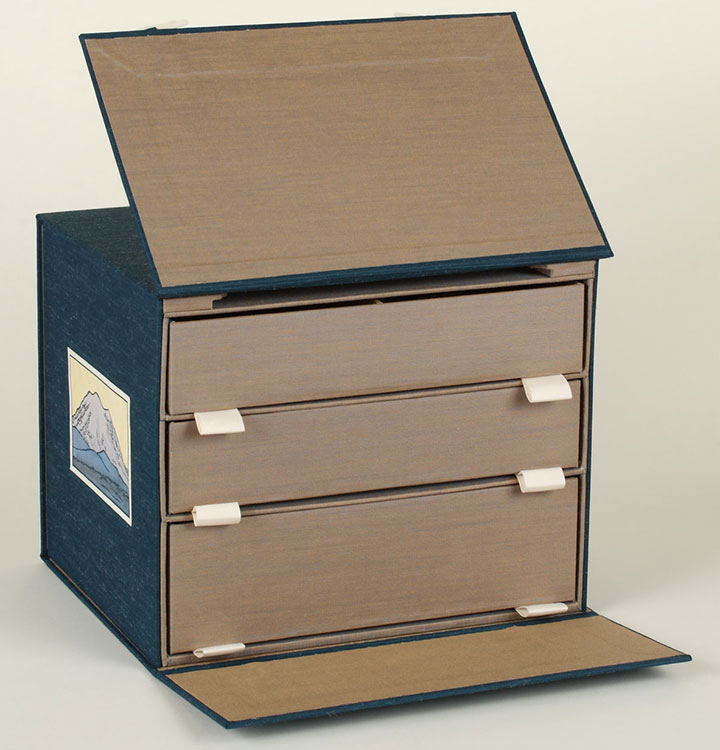
the book opens up, revealing a chest of drawers. Keep pulling on the flap you just raised,

and you’ll find that you can take the whole outer wrapper off and read the colophon (see below) printed on the inside.
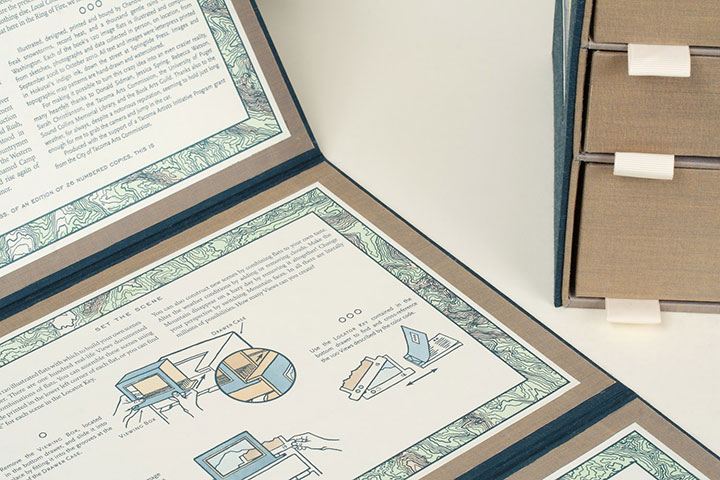
The other panels on the wrapper include detailed instructions on everything the book does.

Next, let’s open the drawers—nested in the bottom one you’ll find a Viewing Box (yeah, I know … a box, within a box, within a box … sorry.) that consists of a window, a background panel, and two tabs that stick out from either side.

The tabs match up with the grooved unit at the top of the chest of drawers, and the Viewing Box slides into place.

So now the box is fully expanded, and the book is assembled for use. Now comes the fun part.
Take a closer look at the Viewing Box, and open the top two drawers.

Inside the drawers you’ll find a series of cut-out cards, each printed with a different image. These little image flats slide right into the slots of the Viewing Box,
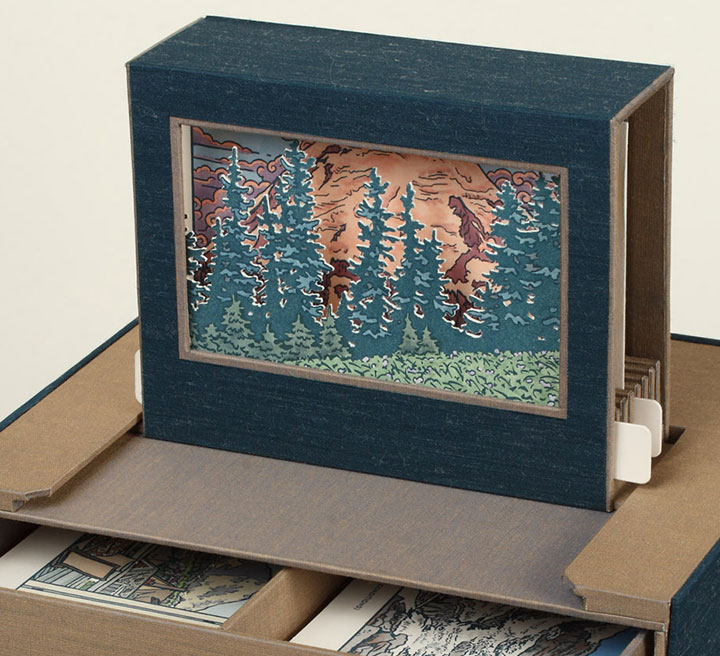
and face out the window to form an instant picture—kind of like an old-fashioned stage set.
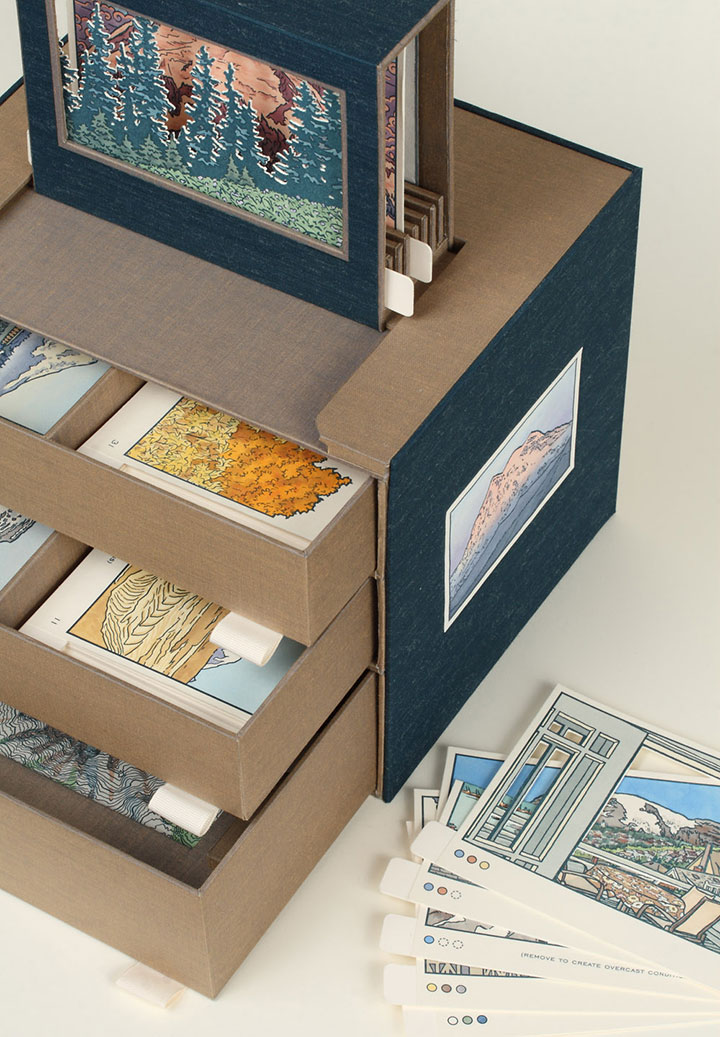
Now here’s the thing:
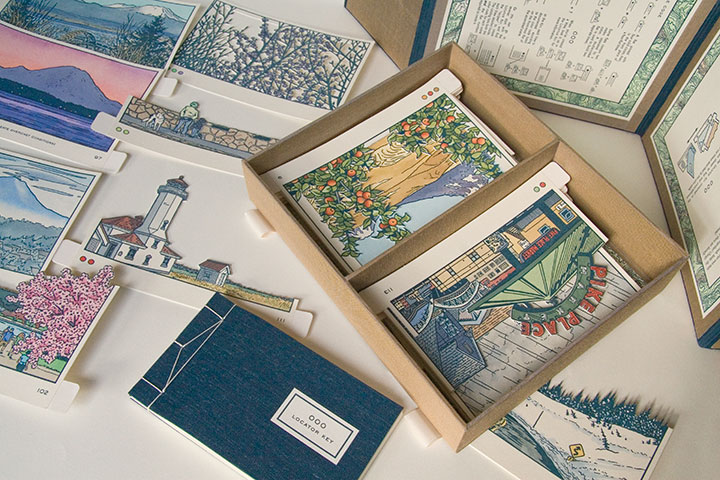
There are 120 flats to choose from. One hundred and twenty. Each one hand-printed, hand-painted, hand-cut.

By combining, layering and switching the flats in and out of the Viewing Box, you can create seemingly endless scenes of Mt Rainier. I came up with one hundred, and documented them as part of the book (again, I’ll elaborate later), but I’m more interested in how many you can dream up.
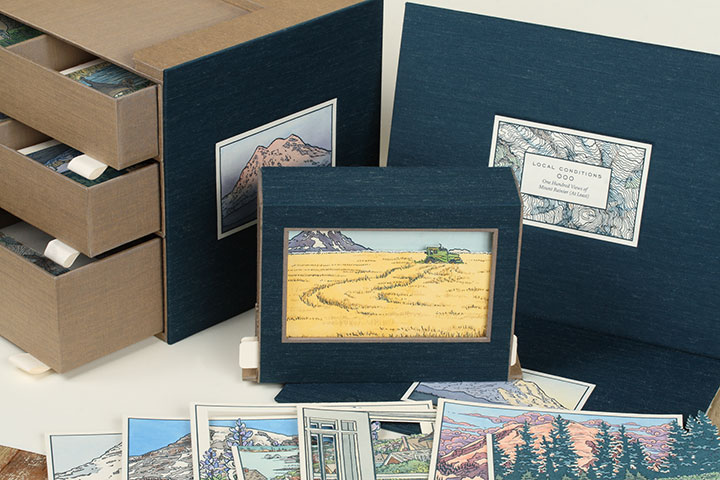
(Hint: a lot. Thousands. Millions. To be precise, 1.4 x 1015, or 1.4 quintillion, if you really wanted to push the envelope.)
• • • • • • • • • • • • • • • • • • • • • • • • • • • • • • • • • • • • • • • • • • • • • • • • • • • • • • • • • • • •
Local Conditions: One Hundred Views of Mt. Rainier (At Least)
Edition size: 26 numbered books and 5 roman-numeraled artist proofs
Book size: 10 x 8 x 8 inches when closed
Viewing window: 3 x 5 inches
Artist book consisting of viewing box and 120 image flats, illustrated and compiled from data collected in person, on location, over the course of two years. Housed in a set of drawers with nested stab-bound book and Japanese-style outer wrapper. Images and maps are hand-drawn, letterpress printed and individually hand-painted with watercolor. All image flats are hand-cut.
For price/purchase info, please contact me.
Edited to add (November 2011): As a supplement to the artist book, I also created a suite of 15 limited-edition letterpress prints, featuring some of my favorite scenes from the book. Just like the flats in the book, each print is letterpress printed and hand-painted with watercolor. You can find all 15 prints in the shop.
Colophon reads:
Japanese artist Katsushika Hokusai (1759 – 1849) is perhaps best known for his seminal works, Thirty-Six Views of Mount Fuji and One Hundred Views of Mt. Fuji. The two series of woodblock prints, published from 1829 to circa 1847, depict the sacred peak within the context of landscapes and scenes of daily life. At the heart of the series is Hokusai’s own obsession with immortality, and his fascination with Fuji’s eternal presence.
Therein lies the rub: Fuji is anything but eternal. Beyond the usual, abstract geologic transience of eroding rock and drifting continents, Fuji is an active stratovolcano. Its days—and those of the lives and lands at its base—are numbered.
Here in Washington state, just forty miles southeast of my home, lies Fuji’s taller, more volatile, American twin. Variously named Tacobet, Tahoma and Ti’Swaq’, among others, by the region’s indigenous peoples, or simply “The Mountain” by contemporary locals—its most arbitrary moniker, coined in 1792 by Captain George Vancouver, is the one that stuck: Mount Rainier.
It’s easy to forget Rainier’s impermanence. It has presided over thousands of years of indigenous culture, followed by the encroachment and permanent occupation of white settlers. It oversaw the construction of the Northern Pacific Railroad, the fever of the Klondike Gold Rush, the splendor of the Alaska-Yukon-Pacific Exposition. It stood in judgment while the American descendants of Hokusai’s countrymen were imprisoned beside the wooden-frame rollercoaster of the Western Washington Fairgrounds, at the internment center nicknamed Camp Harmony. And it has watched the rise and decline and rise again of Tacoma, the City of Destiny lovingly misnamed in its honor.
Yet all the while, Rainier has changed as much as the tableau at its feet. Its volcanic restlessness shifts its form, as our capricious Northwestern weather masks its appearance. It hides, or dominates, depending on the time of day or year. Even we have proved a catalyst, as our warming climate chases its alpine glaciers into retreat at the speed of industry.
And one day—whether tomorrow or in a million years, in an explosion of ash or by the erosion of time—Mount Rainier will disappear completely. I can’t begin to predict the future, but I can attempt to capture the present moment. One hundred present moments, to be exact. If nothing else, Local Conditions is a reminder of the lesson of this place: that here in the Ring of Fire, we never see the same Mountain twice.
* * *
Illustrated, designed, printed and bound by Chandler O’Leary, through freak snowstorms, record heat, and a thousand gentle rains in Tacoma, Washington. Each of the book’s 120 image flats is illustrated and compiled from sketches, photographs and data collected in person, on location, from September 2008 to October 2010. All text and images were letterpress printed in Hokusai’s indigo ink, down the street at Springtide Press. Images and topographic map patterns are hand-drawn and watercolored.
For making it possible to turn this crazy idea into an even crazier reality, many heartfelt thanks to Jessica Spring, Sarah Christianson, the Tacoma Arts Commission, the University of Puget Sound Collins Memorial Library, and the Book Arts Guild. Thanks also to the weather, for always, despite a notorious reputation, seeming to hold just long enough for me to grab the camera and jump in the car.
Produced with the support of a Tacoma Artists Initiative Program grant from the City of Tacoma Arts Commission.
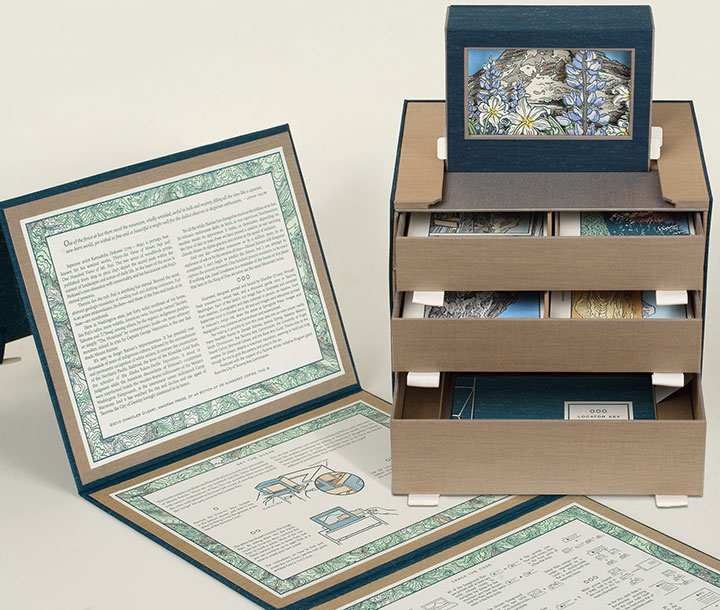
November 5th, 2010
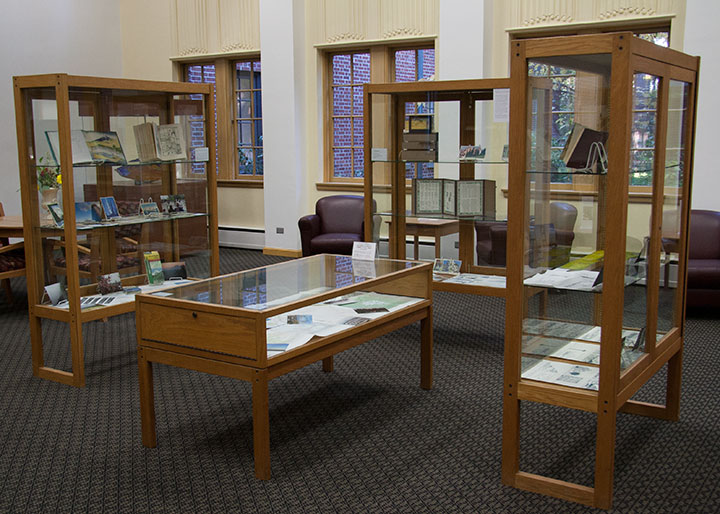
Photos by Sarah Christianson
The show is all set up,
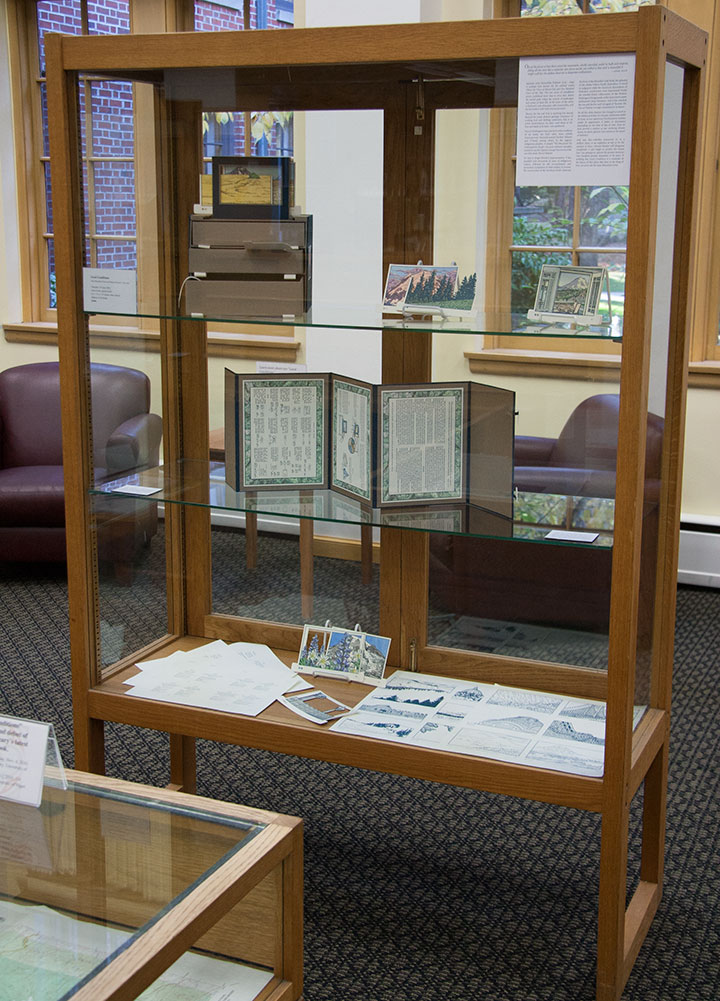
and the book is officially out in the world.
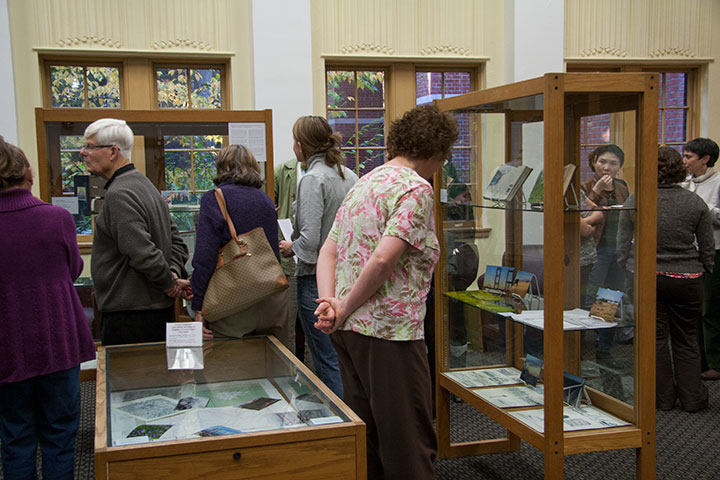
Many thanks to the enormous crowd of folks who descended upon the opening last night—and to my amazing friend Sarah Christianson for providing every kind of emotional and practical support I can think of.
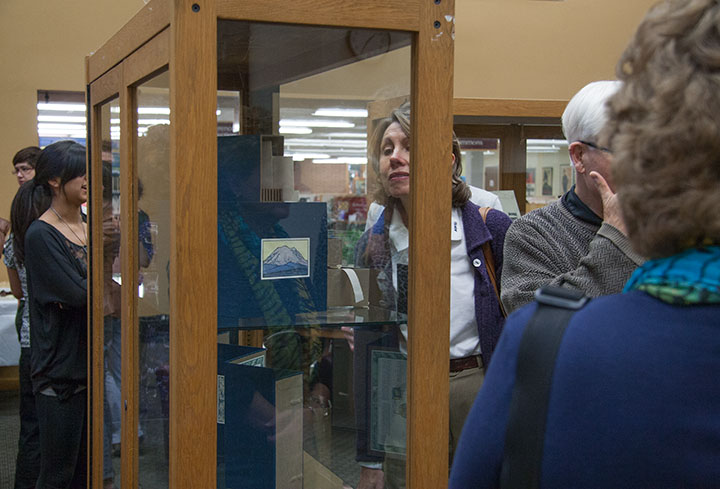

![Chandler O'Leary [logo]](https://chandleroleary.com/wp-content/themes/chandleroleary/images/logo.png)

































































